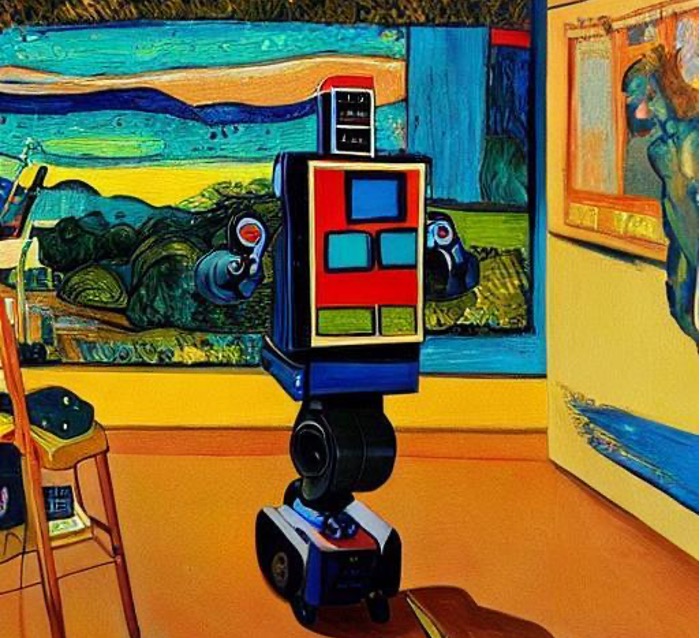Contemporary humans vs. machines of war? AI art in the spotlight
Elena Ramos Esteban

Image created by Openart.ai with the prompt: “AI represented as robot, painting a piece of art, with a paintbrush, in an art studio, Van Gogh style”
More than two centuries ago peasants came to the conclusion that machines were dangerous. Machines were taking away their jobs; machines were creating low-quality products and worsening their already poor working conditions. They started destroying them, especially the weavers, and the social movement of Luddism was born. These days, technology means not only replicating the skilful hands of spinners. It also means replicating the creativity and vision of artists. Artificial intelligence is currently able to create paintings, music and poems with low human mediation. The cycle is repeating itself, and some would burn the machine if there were a machine to burn, but AI has no material. So, how can art be defended?
The question is even broader. Is AI even capable of achieving our current idea of art? Some years ago, the answer would have been easy: there is no art without an artist, as it is the highest manifestation of human nature. This kind of content, also known as computational or generative art, is created by algorithms and machine learning models that analyse patterns, styles and aesthetics from existing works of art or datasets, and then create new pieces based on this knowledge. AI art generators also need prompts, human instructions that, for the ones defending the new media, are a whole literary genre and add the creativity and originality the machine lacks. To the majority, this is not enough. As the French painter Paul Cézanne stated, “a work of art which isn’t based on feeling isn’t art at all”1.
However, this existentialist debate, although necessary, remains distant from the actual dangers to artists AI is already posing. It blurs the established criteria for ownership, as the technology is fed with and trained on actual human work. Painters spend hundreds of hours creating their work. Before this, they have spent time and money finding and practising their style. They then upload their pictures to the internet to find a showcase, only to find that artificial intelligence has included them in its database and is able to create a sufficiently convincing substitute for their work, so making it non-exclusive.
There are also concerns about data privacy and problematic biases and stereotypes perpetuated by this technology. If the training data for an AI model consists of works of art or images that contain stereotypes or racial biases, the model may learn to reproduce these biases in the art it generates. Underrepresentation of certain minorities may also occur. For example, DALL-E, an AI system that can create realistic images through human prompts, was proved to create only pictures of white men when the prompt was ‘CEO’. When the prompt was ‘nurse’, it created only images of women.
We can use these kinds of technologies to illustrate articles like this, create soundtracks for films or advertise products. In 2018, “Portrait of Edmond de Belamy”, a painting created by the French art collective Obvious using a machine-learning model, was sold at auction for over $400,000. The concerns of artists, collectors and art dealers that this could devalue traditional artistic skills and reduce opportunities for human artists as they strive to create and sell their work seem legitimate.
The future of a precarious sector is at stake. For Esther Frasquet Ricarte, a multimedia engineering student who is used to mixing both technology and art, not knowing if in a couple of years her field of study will be obsolete is a cause of stress. But she is also excited by what artificial intelligence may bring to it and thinks the main source of worry is uncertainty. As a remedy, there should be regulation to make AI a tool that creates “a thing that is not art. Because it resembles it, labelling should be mandatory”.
When digital painting devices first appeared, traditional painters raised their brushes to claim hegemony. The same happened with musicians concerned that their natural talents were being matched with no effort by the rise of autotune. Now these tools are well established. The fight against technology, as the Luddites discovered, is a fight against the idea of progress. Because it is here to make our work easier, right?
This is a contested topic too. In this new debate there is a twist. Machines have come to generate more profit, but they have also freed workers from the heaviest, most repetitive and most dangerous jobs. Art is on the other side of the spectrum. From the wide range of professions and fields of work that technology can assume, choosing one that is intrinsically human and related to creativity and sensibility may seem disappointing. When a profession disappears because it is no longer profitable, a new, better qualified one comes along. It follows from this that maybe the days of the artist are numbered.
“The attacks against machines didn’t necessarily mean hostilities against them. The machine was only a convenient target to attack,”2 stated Malcom Thomis, one of the highest authorities on Luddism. Coordinated destruction was a means for pressurizing exploitative employers and creating community. Rather than destruction of a machine with no face, protection of the fragile position of artists in a damaged industry may be the route to follow. Perhaps the newly opened topic is the opportunity artists need to spread their concerns and speak up about the need for a new legal framework that not only tames artificial intelligence but also places value on their work.
References
- Gonzalez, M. K. F. (2021, enero 31). Paul Cézanne – biography of the most influential painter. Exploring Your Mind. https://exploringyourmind.com/paul-cezanne-biography-of-the-most-influential-painter/
- Thomis, M. I. (1970). The Luddites: machine-breaking in Regency England. Archon Books.